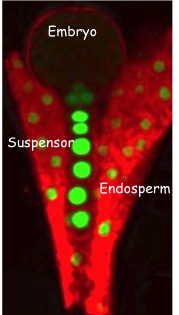Genetic and Epigenetic regulation of early seed development in plants
Seeds have contributed greatly to early civilisation of mankind and, to this day, accounts for a large proportion of the world’s calorific intake.
Plant embryos forms within the seed surrounded by the endosperm- a product of double fertilisation that is unique to flowering plants. The endosperm plays a pivotal placenta-like function in that not only is it necessary for nurturing the embryo, but it also plays a crucial role in regulating embryogenesis through a series of complex genetic and epigenetic interactions that are not very well understood. While both the embryo and endosperm inherit the same genetic information, the developmental fates of these two structures differ greatly; the embryo develops through a fixed pattern of cellular divisions, whereas the endosperm initially develops as a free-nuclear structure that later becomes cellular. The mechanisms that regulate this extraordinary developmental transition are not yet well understood. Moreover, we have recently identified endosperm secreted peptides that regulate zygote elongation and early embryo development. We are currently working on the identification of zygote receptors that regulate this process.

See our latest publication in Science:
"Central Cell–Derived Peptides Regulate Early Embryo Patterning in Flowering Plants" published in Science (Costa et al. 2014)
See latest news arising from our work:
- Embryo development is control by accessory cells
- Regulation of nutrient translocation to offspring

